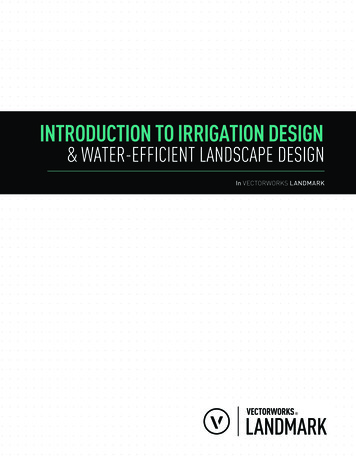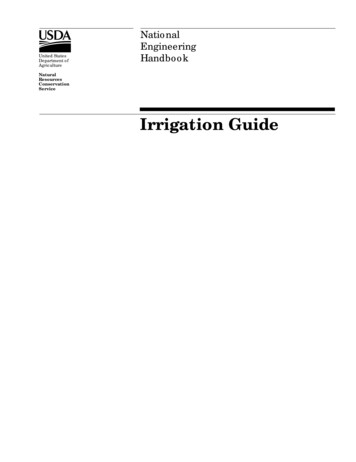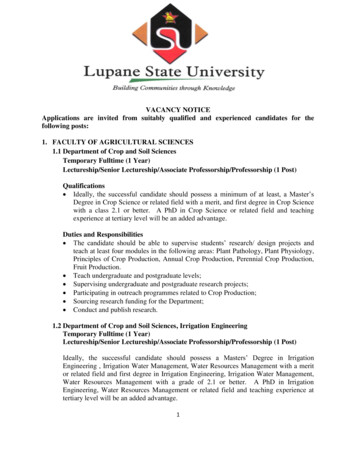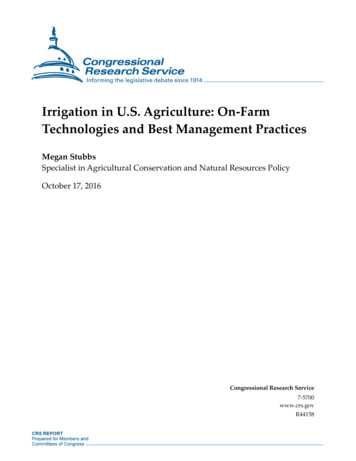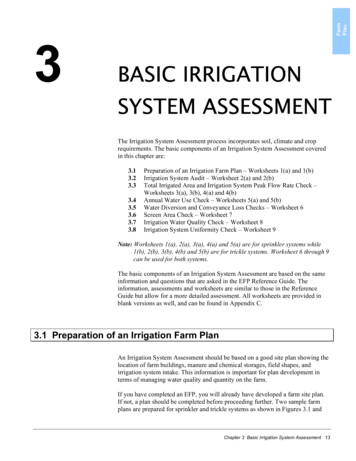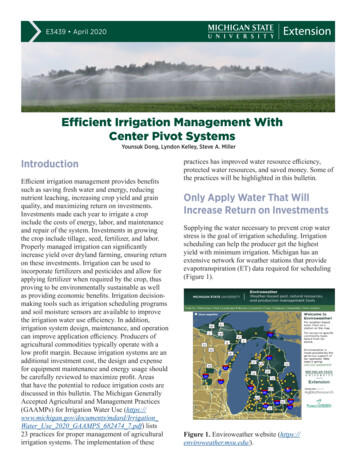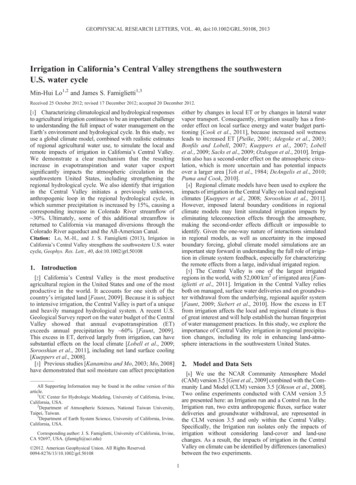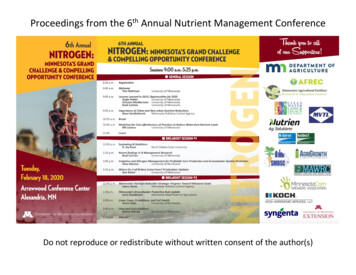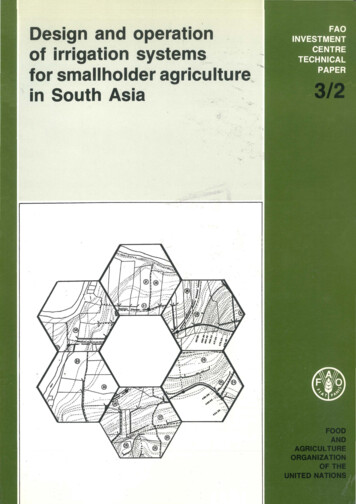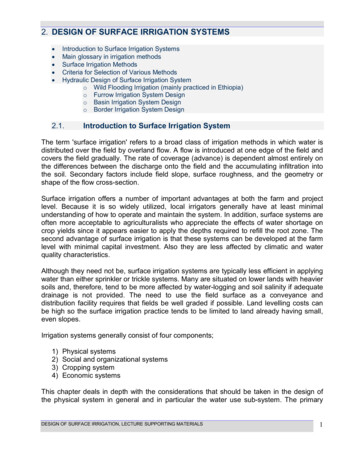
Transcription
2. DESIGN OF SURFACE IRRIGATION SYSTEMS Introduction to Surface Irrigation SystemsMain glossary in irrigation methodsSurface Irrigation MethodsCriteria for Selection of Various MethodsHydraulic Design of Surface Irrigation Systemo Wild Flooding Irrigation (mainly practiced in Ethiopia)o Furrow Irrigation System Designo Basin Irrigation System Designo Border Irrigation System Design2.1.Introduction to Surface Irrigation SystemThe term 'surface irrigation' refers to a broad class of irrigation methods in which water isdistributed over the field by overland flow. A flow is introduced at one edge of the field andcovers the field gradually. The rate of coverage (advance) is dependent almost entirely onthe differences between the discharge onto the field and the accumulating infiltration intothe soil. Secondary factors include field slope, surface roughness, and the geometry orshape of the flow cross-section.Surface irrigation offers a number of important advantages at both the farm and projectlevel. Because it is so widely utilized, local irrigators generally have at least minimalunderstanding of how to operate and maintain the system. In addition, surface systems areoften more acceptable to agriculturalists who appreciate the effects of water shortage oncrop yields since it appears easier to apply the depths required to refill the root zone. Thesecond advantage of surface irrigation is that these systems can be developed at the farmlevel with minimal capital investment. Also they are less affected by climatic and waterquality characteristics.Although they need not be, surface irrigation systems are typically less efficient in applyingwater than either sprinkler or trickle systems. Many are situated on lower lands with heaviersoils and, therefore, tend to be more affected by water-logging and soil salinity if adequatedrainage is not provided. The need to use the field surface as a conveyance anddistribution facility requires that fields be well graded if possible. Land levelling costs canbe high so the surface irrigation practice tends to be limited to land already having small,even slopes.Irrigation systems generally consist of four components;1)2)3)4)Physical systemsSocial and organizational systemsCropping systemEconomic systemsThis chapter deals in depth with the considerations that should be taken in the design ofthe physical system in general and in particular the water use sub-system. The primaryDESIGN OF SURFACE IRRIGATION, LECTURE SUPPORTING MATERIALS1
purpose of the physical system is to supply water to an area for crop production. ThePhysical systems of Surface irrigation systems as a whole consist of four subsystems.These are:1) The water supply subsystem2) The water delivery subsystem3) The water use subsystem4) The water removal subsystemi)Water delivery systemThe function of water delivery sub- system is to convey water from the source to fieldthrough main canal, distributaries, minors and field channels, at constant, regulated rate, atproper elevation, with seepage controlled, with out excessive erosion or sediment taken,with appropriate water quality and amount.ii) Water supply sub –systemsThe output from water delivery sub–system is the input for water application sub–system.Functions: - To distribute the desired amount of water with the designed uniformity over the field.- To satisfy erosion control standards- To provide necessary surface drainageiii) Water use sub- systemThe water use sub- system receives water from the application sub –system.Functions: - To supply the water requirement of the crop.- To maintain acceptable level of soil salinity.- To ensure adequate nutrients.- To provide soil conditions for supporting plants, preventing soil crusting facilitatingtillage etciv) Water removal sub –systemThis sub –system is used for removal and disposal of surface and sub- surface waters fromland to improve agriculture operations.Functions: - To provide proper root aeration by lowering ground water table,- To maintain appropriate salinity levels with in the soil profile,- To dispose (remove) excess irrigation or rain water from the field.DESIGN OF SURFACE IRRIGATION, LECTURE SUPPORTING MATERIALS2
Figure 2.1 Typical Irrigation System ComponentsA surface irrigation event is composed of four phases as illustrated graphically in Figure2.2. When water is applied to the field, it 'advances' across the surface until the waterextends over the entire area. It may or may not directly wet the entire surface, but all of theflow paths have been completed. Then the irrigation water either runs off the field or beginsto pond on its surface. The interval between the end of the advance and when the inflow iscut off is called the wetting or ponding phase. The volume of water on the surface begins todecline after the water is no longer being applied. It either drains from the surface (runoff)or infiltrates into the soil. For the purposes of describing the hydraulics of the surface flows,the drainage period is segregated into the depletion phase (vertical recession) and therecession phase (horizontal recession). Depletion is the interval between cut off and theappearance of the first bare soil under the water. Recession begins at that point andcontinues until the surface is drained.Summarising the four distinct hydraulic phases of surface irrigation system:1. Advance phase: the time interval between the start of irrigation and arrival of theadvancing (wetting) front at the lower end of the field.DESIGN OF SURFACE IRRIGATION, LECTURE SUPPORTING MATERIALS3
2. Ponding (wetting storage or continuing) phase: the irrigation time extending betweenthe end of advance and inflow cutoff. The term “Wetting” phase is usually used forfurrow and border where tail water runoff can occur, whereas ponding is the preferredterm for basin irrigation (no tail water runoff).3. Depletion (vertical recession) phase: the time interval between supply cut-off and thetime that water dries up at the inlet boundary.4. Recession (horizontal recession) phase: the time required for the water to recedefrom all points in the channel, starting from the end of the depletion phase. The timedifference at each measuring station between the clock time or cumulative time foradvance and recession is the opportunity time, T, infiltration to occur.5. Cut off time (tco): Cumulative time since the initiation of irrigation until the inflow isterminated.6. Cutback irrigation: The practice of using a high unit discharge during the advancephase and a reduced one during the wetting or ponding phase to control runoff7. Opportunity time (τ req): The cumulative time between recession and advance at aspecific point on the surface irrigated field. Usual units are minutes or hours.Figure 2.2: Time-space trajectory of water during a surface irrigation showing its advance,wetting, depletion and recession phases.DESIGN OF SURFACE IRRIGATION, LECTURE SUPPORTING MATERIALS4
The time and space references shown in Figure 2.2 are relatively standard. Time iscumulative since the beginning of the irrigation, distance is referenced to the point waterenters the field. The advance and recession curves are therefore trajectories of the leadingand receding edges of the surface flows and the period defined between the two curves atany distance is the time water is on the surface and therefore also the time water isinfiltrating into the soil.It is useful to note here that in observing surface irrigation one may not always observe aponding, depletion or recession phase. In basins, for example, the post-cut off period mayonly involve a depletion phase as the water infiltrates vertically over the entire field.Likewise, in the irrigation of paddy rice, irrigation very often adds to the ponded water in thebasin so there is neither advance nor recession - only wetting or ponding phase and part ofthe depletion phase. In furrow systems, the volume of water in the furrow is very often asmall part of the total supply for the field and it drains rapidly. For practical purposes, theremay not be a depletion phase and recession can be ignored. Thus, surface irrigation mayappear in several configurations and operate under several regimes.2.2.Surface Irrigation MethodsSurface irrigation system for the specific needs will be considered with the followingfactors: costs of the system and its appurtenances, field sizes and shapes, soil intake and water holding characteristics, the quality and availability (timing of deliveries, amount and duration of delivery) of thewater supply, climate, cropping patterns, historical practices and preferences, and accessibility to precision land levelling services.Wild FloodingThere are many cases where croplands are irrigated without regard to efficiency oruniformity. These are generally situations where the value of the crop is very small or thefield is used for grazing or recreation purposes. Small land holdings are generally notsubject to the array of surface irrigation practices of the large commercial farming systems.Also in this category are the surface irrigation systems like check-basins which irrigateindividual trees in an orchard, for example. While these systems represent significantpercentages in some areas, they will not be discussed in detail in this paper. Theevaluation methods can be applied if desired, but the design techniques are not generallyapplicable nor need they be since the irrigation practices tend to be minimally managed.DESIGN OF SURFACE IRRIGATION, LECTURE SUPPORTING MATERIALS5
Fig. 2.3 Wild FloodingBasin IrrigationBasin irrigation is the most common form of surface irrigation, particularly in regions withlayouts of small fields. If a field is level in all directions, is encompassed by a dyke toprevent runoff, and provides an undirected flow of water onto the field, it is herein called abasin. A basin is typically square in shape but exists in all sorts of irregular and rectangularconfigurations. It may be furrowed or corrugated, have raised beds for the benefit of certaincrops, but as long as the inflow is undirected and uncontrolled into these fieldmodifications, it remains a basin.There are few crops and soils not amenable to basin irrigation, but it is generally favouredby moderate to slow intake soils, deep-rooted and closely spaced crops. Crops which aresensitive to flooding and soils which form a hard crust following irrigation can be basinirrigated by adding furrowing or using raised bed planting. Reclamation of salt-affectedsoils is easily accomplished with basin irrigation and provision for drainage of surfacerunoff is unnecessary.Figure 2.4: Isometric View of Level Basin SystemDESIGN OF SURFACE IRRIGATION, LECTURE SUPPORTING MATERIALS6
Basin irrigation has a number of limitations, two of which, already mentioned, areassociated with soil crusting and crops that cannot accommodate inundation. Precisionland levelling is very important to achieving high uniformities and efficiencies. Many basinsare so small that precision equipment cannot work effectively. The perimeter dykes need tobe well maintained to eliminate breaching and waste, and must be higher for basins thanother surface irrigation methods. To reach maximum levels of efficiency, the flow per unitwidth must be as high as possible without causing erosion of the soil. When an irrigationproject has been designed for either small basins or furrows and borders, the capacity ofcontrol and outlet structures may not be large enough to improve basins.The flow rate must be large enough to cover the entire basin approximately 60 to 75percent of the time required for the soil to absorb the desired amount of water.Basin irrigation can be used to apply prescribed application depths at design efficiencies ofmore than 90%. However, studies on basin irrigation systems in various countries havedocumented both extensive over and under-irrigation as the norm, which has resulted inoverall low irrigation efficiencies.Basin irrigation is suited to different crops, such as, rice, cotton, groundnuts etc. and tosoils of moderate to low intake rate (50 mm/h or less) having smooth, gentle and uniformland slopes. The method is especially adapted to irrigation of grain and fodder crops inheavy soils where water is absorbed very slowly and is required to stand for a relativelylong time to ensure adequate irrigation.DESIGN OF SURFACE IRRIGATION, LECTURE SUPPORTING MATERIALS7
Figure 2.5 Basin IrrigationBorder IrrigationBorder irrigation can be viewed as an extension of basin irrigation to sloping, longrectangular or contoured field shapes, with free draining conditions at the lower end. Figure2.6 illustrates a typical border configuration in which a field is divided into sloping borders.Water is applied to individual borders from small hand-dug checks from the field headditch. When the water is shut off, it recedes from the upper end to the lower end. Slopingborders are suitable for nearly any crop except those that require prolonged ponding. Soilscan be efficiently irrigated which have moderately low to moderately high intake rates but,as with basins, should not form dense crusts unless provisions are made to furrow orconstruct raised borders for the crops. The stream size per unit width must be large,particularly following a major tillage operation, although not so large for basins owing to theeffects of slope. The precision of the field topography is also critical, but the extendedlengths permit better levelling through the use of farm machinery.Figure 2.6: Isometric View of Border Irrigation SystemDESIGN OF SURFACE IRRIGATION, LECTURE SUPPORTING MATERIALS8
Border irrigation makes use of parallel earth rides to guide a sheet of flowing water acrossa field. The land between two levees is called a border strip, simply called a border. Borderstrips, like basins, can be described as rectangular channels (narrow or wide) in which thewidth of flow plays a dominant role in affecting the geometric elements of the channel. Theborder strip may vary from 3 to 30 meters in width and from 100 to 800 meters in length.Border irrigation is a more controlled version of wild flooding with additional field ditchesthat serve as supply sources for applying water to the field.Border irrigation is generally well suited to soils with moderately high intake rates and toslopes less than 0.5 percent. The method can be classified as straight or contour bordersdepending on weather the borders are running along or across the main slope.Borders can be grouped into three major categories depending on the managementstrategy adopted:Fixed flow: a system in which the inlet flow rate remains constant throughout the durationof irrigation, the method is simple and less expensive but generally of low efficiency.Cutback: this is a system in which irrigation begins with a maximum or near maximum nonerosive inlet flow rate, which continues for a part of the irrigation period and then reducedto a level just above what is needed to wet the entire length of the border.Tail water reuse: this is a system in which excess surface runoff from the downstream endis collected in a sump and then pumped back into the same field to open up more bordersor used to irrigate another field.Field application efficiency is good to excellent if the border strips are designed andinstalled properly and good water management practices are followed. Design waterapplication efficiencies of the order 70 -75 % can be attained for slopes of 0.001 to 0.002m/m on soils of silty clay to clay with depth of application of 75 - 100 mm. For highefficiencies, the stream size and the resulting rate of advance must be controlled to matchthe recession conditions to provide approximately equal infiltration opportunity time at boththe upper and lower ends.Figure 2.7: Border IrrigationDESIGN OF SURFACE IRRIGATION, LECTURE SUPPORTING MATERIALS9
Furrow IrrigationFurrow irrigation avoids flooding the entire field surface by channelling the flow along theprimary direction of the field using 'furrows,' 'creases,' or 'corrugations'. Water infiltratesthrough the wetted perimeter and spreads vertically and horizontally to refill the soilreservoir. Furrows are often employed in basins and borders to reduce the effects oftopographical variation and crusting. The distinctive feature of furrow irrigation is that theflow into each furrow is independently set and controlled as opposed to furrowed bordersand basins where the flow is set and controlled on a border by border or basin by basinbasis.Furrows provide better on-farm water management flexibility under many surface irrigationconditions. The discharge per unit width of the field is substantially reduced andtopographical variations can be more severe. A smaller wetted area reduces evaporationlosses. Furrows provide the irrigator more opportunity to manage irrigations toward higherefficiencies as field conditions change for each irrigation throughout a season. This is not tosay, however, that furrow irrigation enjoys higher application efficiencies than borders andbasins.There are several disadvantages with furrow irrigation. These may include: (1) anaccumulation of salinity between furrows; (2) an increased level of tail water losses; (3) thedifficulty of moving farm equipment across the furrows; (4) the added expense and time tomake extra tillage practice (furrow construction); (5) an increase in the erosive potential ofthe flow; (6) a higher commitment of labour to operate efficiently; and (7) generally furrowsystems are more difficult to automate, particularly with regard to regulating an equaldischarge in each furrow. Figure 4.5 shows two typical furrow irrigated conditions.(a) Graded furrow irrigation systemDESIGN OF SURFACE IRRIGATION, LECTURE SUPPORTING MATERIALS10
(b) Contour furrowsFigure 2.8: Furrow irrigation configurations (after USDA-SCS, 1967)Figure 2.9 Typical furrow cross-section (wetting Pattern)DESIGN OF SURFACE IRRIGATION, LECTURE SUPPORTING MATERIALS11
When properly designed and operated, furrow irrigation systems may result in a goodperformance. The wide variations in furrow cross-section types as well as the twodimensional nature of the infiltration process under furrow irrigation complicatesmathematical analysis and field measurement needed to quantify irrigation parameterscompared to other two methods.Efforts to achieve high application efficiencies for furrow-irrigated systems are limited byvery large spatial and temporal variation in infiltration characteristics. Thus, whileefficiencies of 85 to 90 % are periodically reported from studies incorporating careful soilmoisture monitoring and automation, efficiencies in the order of 50 to 70 % are morecommon. Moreover, designs could be acceptable if the water application efficiency isgreater than 70 percent, with less than 10 percent deep percolation and 20 percent runofflosses, while storage efficiency is greater than 85 to 90 percent.Most crops would be irrigated by the furrow method and is best suited to medium tomoderately fine textured soils with relatively high water holding capacity and conductivitywhich allow significant water movement in both the horizontal and vertical directions. Likeborder irrigation, furrow irrigation systems, can be grouped into fixed flow, cutback flow andtail-water reuse system depending on the management strategy adopted.2.3.Criteria for the selection of the various methodsThe choice of irrigation system is frequently determined by certain limiting conditions thatpreclude one or another of the possibilities and may leave no alternative. The importantfactors that should be taken into account when determining which surface irrigation methodis most suitable: basin, border or furrow irrigation are natural circumstances (slope, soiltype), type of crop, required depth of application, level of technology, previous experienceswith irrigation, required labor input. Moreover the irrigation system for a field must becompatible with the existing farming operations, such as land preparation, cultivation, andharvesting practices.Natural circumstancesFlat lands, with a slope of 0.1 % or less, are best suited for basin irrigation: little landleveling will be required. Furrow irrigation can be used on flat lands (short, near horizontalfurrows), and on mildly sloping land with a slope of maximum 0.5 %. A minimum slope of0.05 % is recommended to assist drainage.Border irrigation can be used on sloping land up to 2 % on sandy soil and 5 % on clay soil.A minimum slope of 0.05 % is recommended to ensure drainage. Generally, surfaceirrigation may be difficult to use irregular slopes, as considerable land leveling may berequired to achieve the required land gradients.Type of cropPaddy rice is always grown in basins. Those crops that cannot stand a very wet soil formore than 12-24 hours should not be grown in basins. Furrow irrigation is best suited forirrigating row crops such as maize, vegetables and trees. Border irrigation is particularlyDESIGN OF SURFACE IRRIGATION, LECTURE SUPPORTING MATERIALS12
suitable for close growing crops such as small grains (sesame) and forage crops (alfalfa),but border irrigation can be used for row crops and trees.Required depth of irrigation applicationWhen the irrigation schedule has been determine, it is known how much water has to begiven per irrigation application It must be checked that this amount can be indeed be given,with the irrigation method under consideration. Field experience has shown that most watercan be applied per irrigation application when using basin irrigation, less with borderirrigation and least with furrow irrigation. In practice in small-scale irrigation projects,usually 40 –70 mm of water are applied in basin irrigation, 30 – 60 mm in border irrigationand 20 – 50 mm in furrow irrigation. If, on the other hand, a large amount of irrigation wateris to be applied per application, e.g. on clay soil and with a deep rooting crop, border orbasin irrigation would be more appropriate.Level of technologyBasin irrigation is the simplest of the surface irrigation methods. Especially if the basins aresmall, they can be constructed by hand or animal traction. Their operation andmaintenance is simple. Furrow irrigation with the possible exception of short, level furrowsrequires accurate grading. Machines often do this. The maintenance ploughing andfurrowing is often done by machines. This requires skill, organization and frequently theuse of foreign currency for fuel, equipments and spare parts. Borders require the highestlevel of sophistication. They are constructed and maintained by machines. The gradingneeds to be accurate. Machine operation requires a high level of skill, organization andusually foreign currency.Required labor inputsThe required labor inputs for construction and maintenance depend heavily on the extent towhich machinery is used. In general it can be stated that to operate the system, basinirrigation requires the least labor and least skill. For the operation of furrow and borderirrigation systems more labor is required combined with more skill.DESIGN OF SURFACE IRRIGATION, LECTURE SUPPORTING MATERIALS13
Table 1 Differences and similarities of the three primary surface irrigation systems.ItemMain slopeSoilsInfiltrationField sizeGeometryshapeof farmSediment loadBiological qualitySalinityCrops varietyFarming machineryLabor evel of technologyrequirementsInitial costPrincipal risk2.4.Furrow 1%BorderUp to 2-5 %(min. 0.05%)Best suited to soilswith moderate to lowintake rates.two dimensional(min. 0.05%)moderately low tomoderately highintake rate soilssame as basinlargeregularlargeregularone dimensional andvertically downwardAll sizeall shapenot problematicnot problematicproblem if very highsaltbest for row cropsnot problematicnot problematicslightly problematicnot problematicnot problematicnot problematicbest for close growingcropseasy to applyall crops but best forponded water cropsdifficult to usehighleast labor comparedto other surfaceirrigation systems65 –80 %adapted tomechanized farminghighBasinUsually zero slope ornearly zero attainedmedium to finetextured soils60- 70%60- 70 %Relatively lowlower than borderHigh with blockedendshighestsimplestlow to lic design of Surface Irrigation SystemsThe design of a surface irrigation system first involves assessing the general topographicconditions, soils, crops, farming practices anticipated and farm operators’ desires andfinance for the field or farm in question. Moreover, the first priorities in agriculture today isthe development of irrigation design that are more efficient in the use of both water andenergy resources for the varieties of crops and farming practices.One of the purposes of design of surface irrigation systems is to facilitate operationalpractices so that the system can be managed and operated according to the plan and thedesired goal can be achieved.Surface irrigation systems are designed and operated to supply the individual irrigationrequirements of each field on the farm while controlling deep percolation, runoff,evaporation and operational losses. Beside this, the objective of any water application is toDESIGN OF SURFACE IRRIGATION, LECTURE SUPPORTING MATERIALS14
uniformly replenish the root zone moisture with enough percolation for the effectiveleaching of harmful salts.Properly designed and operated surface irrigation systems can enhance crop yields. Often,however, inadequate design and management result in excessive water losses throughdeep percolation and/or tail water runoff. It can be also stated that high efficiencies are notgenerally attained with surface methods unless design, operation and management are ofa higher standard and distribution. Despite the fact that surface irrigation is the most widelypracticed method of irrigation and feasible under many circumstances, its low energyrequirements and simplicity of operation, it is not only a major consumer of water but alsoone of the most inefficient users of water.For example, the annual project efficiencies of some selected 16 countries (world wide, byFAO, 1998) ranges from 13 % (Saldana in Colombia) to 99 % (Tadla in Morocco).Similarly, the over all efficiency of state farms in the Middle Awash was about 40 % (1986).Generally, FAO (1995) pointed out that only 40% to 60% of the water is effectively used bythe crop, the reminder of the water is lost in the system, in the farm and on the field, eitherthrough evaporation, through run-off or by percolation into the ground water.Design can be viewed as the process of making decisions concerning the values of flowrate (Qo), length of channel (L), and time of cutoff (tco), prior to the onset of every irrigationseason and during the project development phase. The available stream size, and thelength and grade of the land units must be combined to achieve acceptable results withoutexcessive labor, waste of water, erosion and inconvenience to other farming operations.Since the performance of a surface irrigation system is dependent on three sets ofvariables; design, management, and field variables (system parameters), which are shownin the following functional relationship, it has of a paramount importance to discuss eachone of them in detail.P f ( I, So , n, Zr , G, qo , L, tco )Where P performance of surface irrigationI symbolizes the infiltration parametersSo channel bed slopen hydraulic resistanceG symbolizes geometry parametersZr required amount of applicationqo unit flow rate at the head end of the channeltco time of cut offL furrow lengthDESIGN OF SURFACE IRRIGATION, LECTURE SUPPORTING MATERIALS15
A) Surface irrigation Design inputs (System Parameters and System Variables)Generally there are two types of design data inputs in surface irrigation: field parametersand field decision variables. The designer can manipulate decision variables. They includeflow rate, the field dimensions and cut-off time. On the other hand, however, the designercannot influence Field parameters; they are measured or assumed properties of thegiven situation. They primarily consist of the soil infiltration characteristics, the flowresistance, the required net application depth, and the field slopes (for borders andfurrows).A description (explanation) of each design input parameter as related to its influence,dimensions and the procedures followed to determine each parameter would be presentedin the subsequent sections.System Parameters1. Required amount of application (dn): This parameter represents the amount of waterthat needs to be stored in the crop root zone reservoir during every irrigations, in orderto sustain normal crop growth. The crop type, stage of growth, presence or absence ofshallow water table, and limiting soil horizons (such as hard pans), among other things,determine the effective crop root depth. Soil type is the factor that determines howmuch water can be stored per unit depth of soil. These factors, along with the climaticconditions of an area should be considered to determine the required amount ofapplication (dn). For basins and borders the characteristics width is unit width, i.e. 1m,whereas for furrows it is the furrow spacing.Note: dn is the same as MAD - management allowable depletion or maximum allowabledeficiency. MAD is the soil moisture at which irrigations should be scheduled, and is determinedas:dn MAD TAW * Dr *P , TAW (Field capacity – Wilting point)*Root zone depthFigure Components of soil waterDESIGN OF SURFACE IRRIGATION, LECTURE SUPPORTING MATERIALS16
2. Maximum allowable flow velocity (Vmax): This is used in estimating the non-erosiveflow rate, Q max, which can be turned on into a furrow or a border or a basin withoutcausing soil erosion. The value of Vmax is generally depend on soil type, and may varywithin the range of 8 m/mi
o Border Irrigation System Design 2.1. Introduction to Surface Irrigation System . second advantage of surface irrigation is that these systems can be developed at the farm level with minimal capital investment. Also they are less affected by climatic and water quality characteristics.
